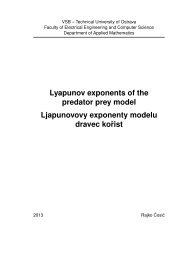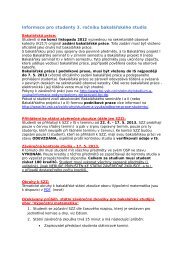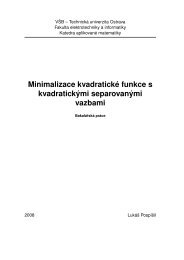The Boundary Element Method for the Helmholtz Equation ... - FEI VÅ B
The Boundary Element Method for the Helmholtz Equation ... - FEI VÅ B
The Boundary Element Method for the Helmholtz Equation ... - FEI VÅ B
You also want an ePaper? Increase the reach of your titles
YUMPU automatically turns print PDFs into web optimized ePapers that Google loves.
7For a special choice of p = 2 we get Hilbert spaces H 1 (Ω) := W 1,2 (Ω) and H0 1 (Ω) :=W 1,20 (Ω) equipped with <strong>the</strong> inner product⟨u, v⟩ H 1 (Ω) := ⟨u, v⟩ L 2 (Ω) + ⟨∇u, ∇v⟩ L 2 (Ω)inducing <strong>the</strong> norm (1.2), which can be rewritten in <strong>the</strong> <strong>for</strong>m∥u∥ H 1 (Ω) := ∥u∥ W 1,2 (Ω) = ∥u∥ 2 L 2 (Ω) + ∥∇u∥2 L 2 (Ω) .In <strong>the</strong> previous two <strong>for</strong>mulae we used <strong>the</strong> notation⟨∇u, ∇v⟩ L 2 (Ω) :=∥∇u∥ 2 L 2 (Ω) :=dk=1dk=1ΩΩ∂u∂x k(x) ∂v∂x k(x) dx,∂u (x)∂x kIn <strong>the</strong> following text we also consider a more restricted space H 1 (Ω, ∆ + κ 2 ) ⊂ H 1 (Ω)with κ ∈ R + defined asH 1 (Ω, ∆ + κ 2 ) := {u ∈ H 1 (Ω): ∆u + κ 2 u ∈ L 2 (Ω)}, (1.3)where <strong>for</strong> smooth functions <strong>the</strong> symbol ∆ stands <strong>for</strong> <strong>the</strong> Laplace operator defined as∆u :=d ∂ 2 u.∂x 2 k=1 kNote that <strong>for</strong> a non-smooth function u <strong>the</strong> corresponding function ∆u + κ 2 u from <strong>the</strong>definition (1.3) must be interpreted in <strong>the</strong> distributional sense, i.e., using <strong>the</strong> definition ofdistributional derivatives (1.1), ∆u + κ 2 u is a distribution satisfying⟨∆u + κ 2 u, ϕ⟩ =d ∂ 2 u∂x 2 , ϕ + κ 2 ⟨u, ϕ⟩ =kk=12dk=1dx.= ⟨u, ∆ϕ + κ 2 ϕ⟩ <strong>for</strong> all ϕ ∈ C ∞ 0 (Ω). u, ∂2 ϕ∂x 2 + κ 2 ⟨u, ϕ⟩k(1.4)We say that ∆u + κ 2 u ∈ L 2 (Ω) in <strong>the</strong> distributional sense if <strong>the</strong>re exists a functionv ∈ L 2 (Ω) satisfyingv(x)ϕ(x) dx = u(x) ∆ϕ(x) + κ 2 ϕ(x) dx <strong>for</strong> all ϕ ∈ C0 ∞ (Ω).ΩToge<strong>the</strong>r with <strong>the</strong> normΩ∥u∥ H 1 (Ω,∆+κ 2 ) :=∥u∥ 2 H 1 (Ω) + ∥∆u + κ2 u∥ 2 L 2 (Ω)









